Abstract
The continuous regions for short-neurotoxin binding on the alpha-chains of Torpedo californica (electric ray) and human acetylcholine receptors (AChR) were localized by reaction of 125I-labelled cobrotoxin (Cot) and erabutoxin b (Eb) with synthetic overlapping peptides spanning the entire extracellular part of the respective alpha-chains. On Torpedo AChR, five Cot-binding regions were found to reside within peptides alpha 1-16, alpha 23-38/alpha 34-49 overlap, alpha 100-115, alpha 122-138 and alpha 194-210. The Eb-binding regions were localized within peptides alpha 23-38/alpha 34-49/alpha 45-60 overlap, alpha 100-115 and alpha 122-138. The main binding activity for both toxins resided within region alpha 122-138. In previous studies we had shown that the binding of long alpha-neurotoxins [alpha-bungarotoxin (Bgt) and cobratoxin (Cbt)] involved the same regions on Torpedo AChR as well as an additional region within residues alpha 182-198. Thus region alpha 182-198, which is the strongest binding region for long neurotoxins on Torpedo AChR, was not a binding region for short neurotoxins. On human AChR, peptide alpha 122-138 possessed the highest activity with both toxins, and lower activity was found in the overlap alpha 23-38/alpha 34-49/alpha 45-60 and in peptide alpha 194-210. In addition, peptides alpha 100-115 and alpha 56-71 showed strong and medium binding activities to Eb, but low activity to Cot, whereas peptide alpha 1-16 exhibited low binding to Cot and no binding to Eb. Comparison with previous studies indicated that, for human AChR, the binding regions of short and long neurotoxins were essentially the same. The finding that the region within residues alpha 122-138 of both human and Torpedo AChR possessed the highest binding activity with short neurotoxins indicated that this region constitutes a universal binding site for long and short neurotoxins on AChR from various species.
Full text
PDF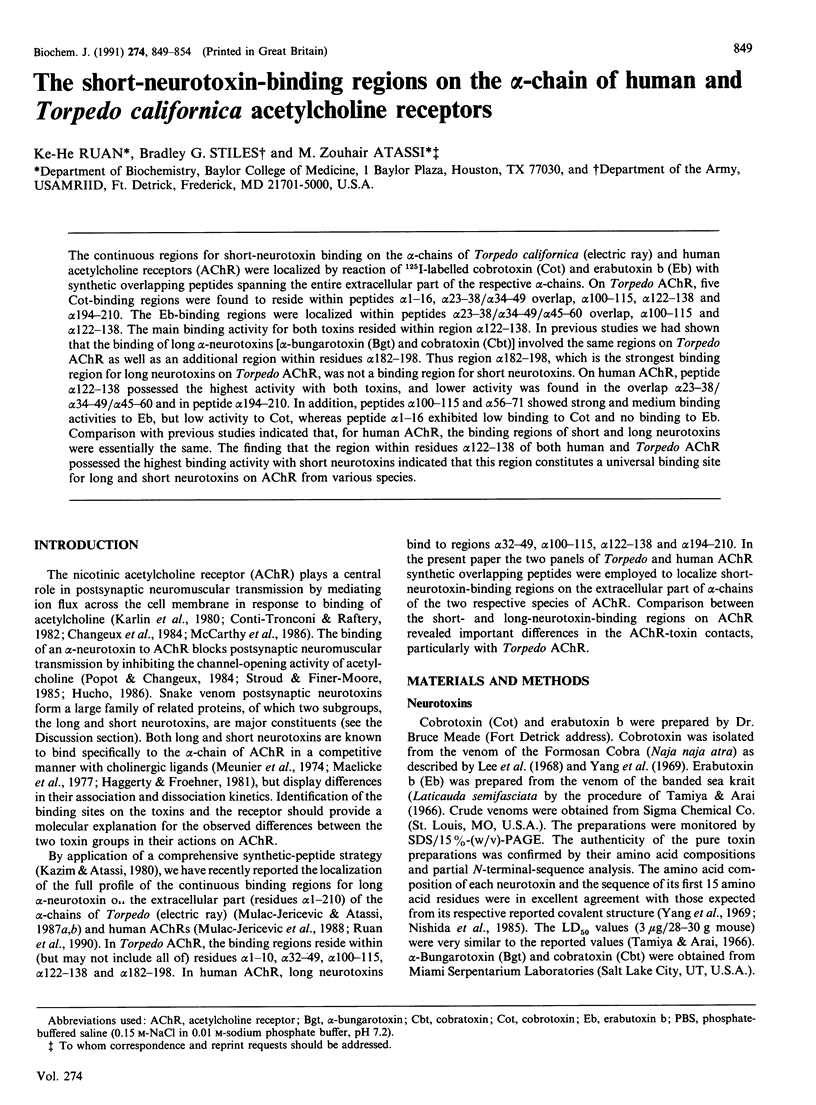
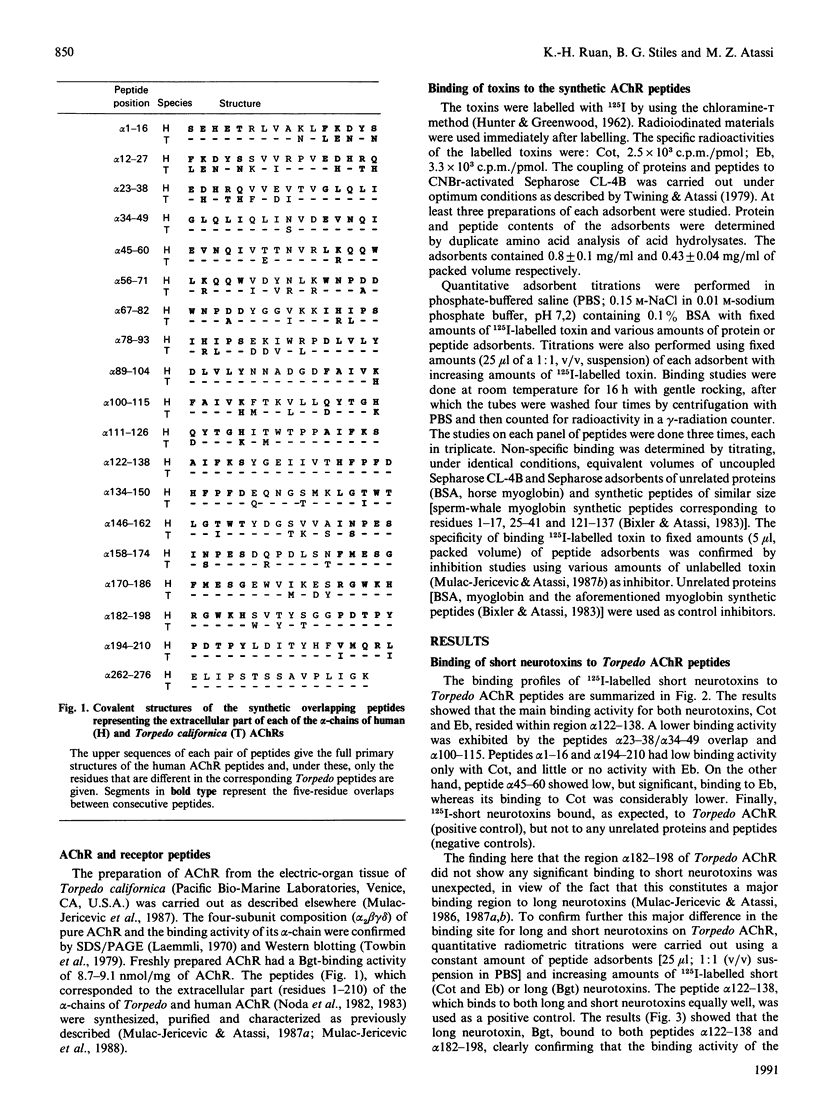
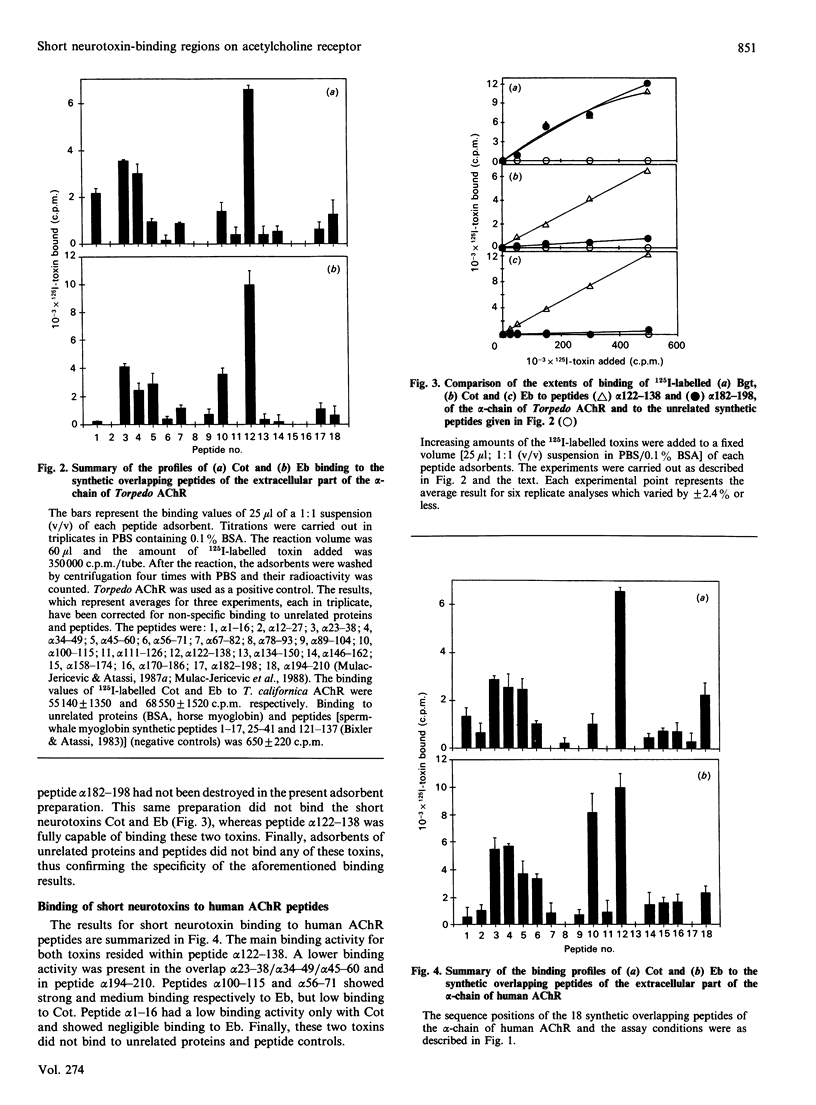
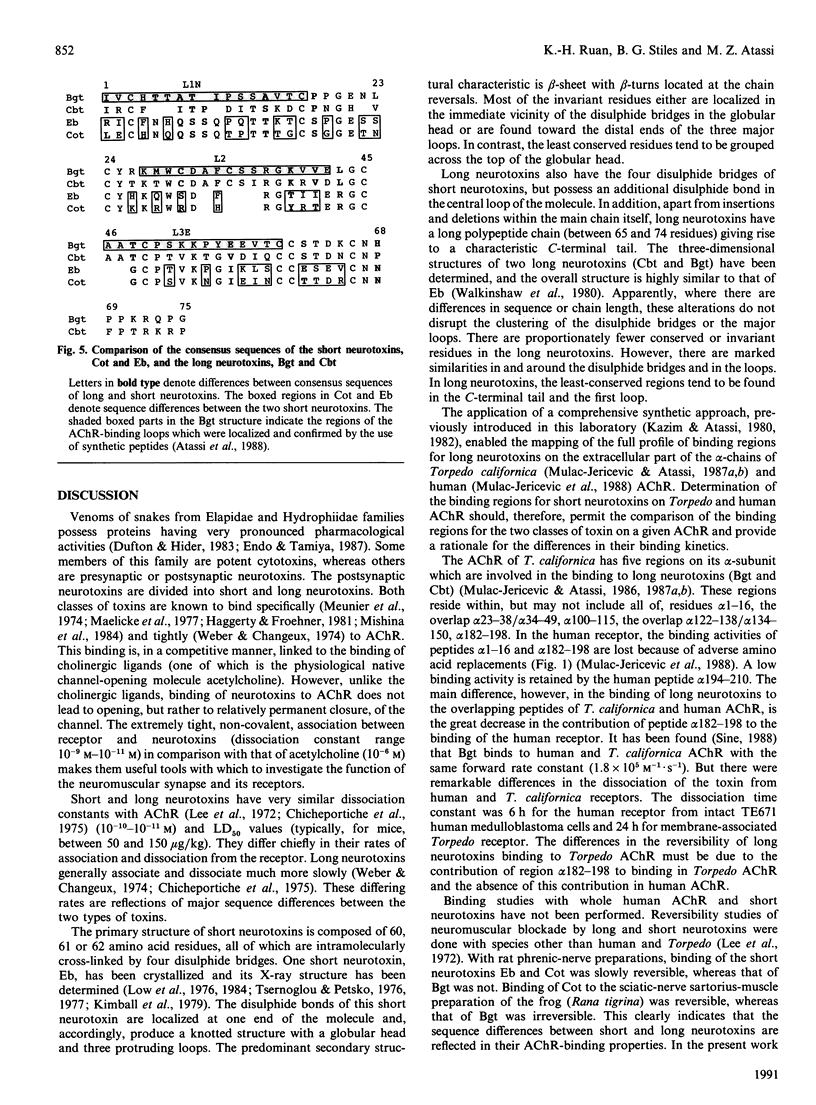
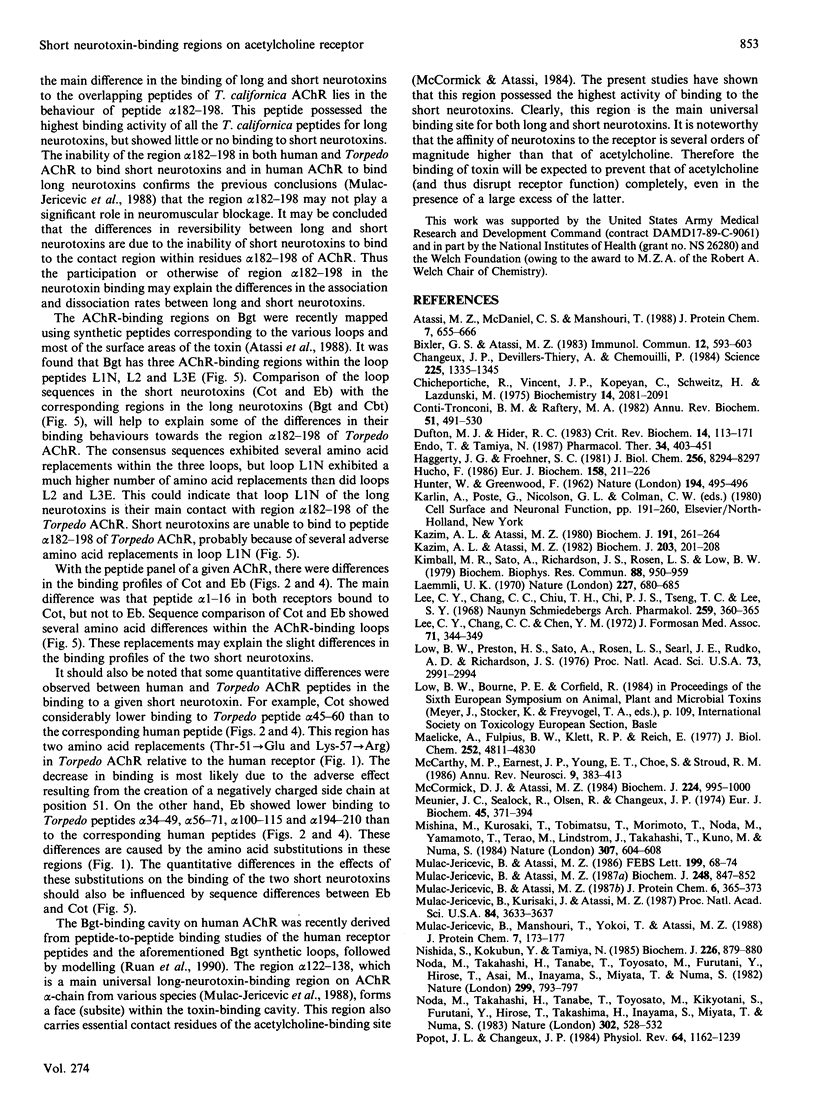
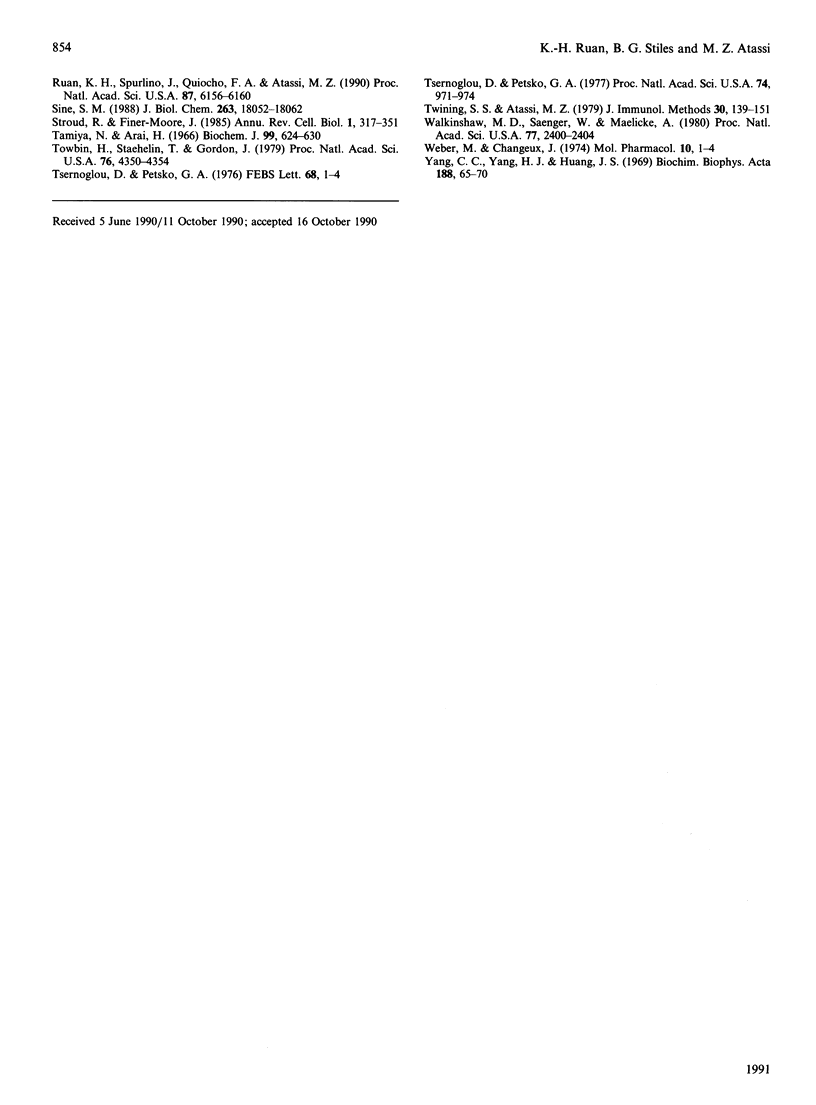
Selected References
These references are in PubMed. This may not be the complete list of references from this article.
- Atassi M. Z., McDaniel C. S., Manshouri T. Mapping by synthetic peptides of the binding sites for acetylcholine receptor on alpha-bungarotoxin. J Protein Chem. 1988 Oct;7(5):655–666. doi: 10.1007/BF01024881. [DOI] [PubMed] [Google Scholar]
- Bixler G. S., Jr, Atassi M. Z. Molecular localization of the full profile of the continuous regions recognized by myoglobin-primed T-cells using synthetic overlapping peptides encompassing the entire molecule. Immunol Commun. 1983;12(6):593–603. doi: 10.3109/08820138309025440. [DOI] [PubMed] [Google Scholar]
- Changeux J. P., Devillers-Thiéry A., Chemouilli P. Acetylcholine receptor: an allosteric protein. Science. 1984 Sep 21;225(4668):1335–1345. doi: 10.1126/science.6382611. [DOI] [PubMed] [Google Scholar]
- Chicheportiche R., Vincent J. P., Kopeyan C., Schweitz H., Lazdunski M. Structure-function relationship in the binding of snake neurotoxins to the torpedo membrane receptor. Biochemistry. 1975 May 20;14(10):2081–2091. doi: 10.1021/bi00681a007. [DOI] [PubMed] [Google Scholar]
- Conti-Tronconi B. M., Raftery M. A. The nicotinic cholinergic receptor: correlation of molecular structure with functional properties. Annu Rev Biochem. 1982;51:491–530. doi: 10.1146/annurev.bi.51.070182.002423. [DOI] [PubMed] [Google Scholar]
- Dufton M. J., Hider R. C. Conformational properties of the neurotoxins and cytotoxins isolated from Elapid snake venoms. CRC Crit Rev Biochem. 1983;14(2):113–171. doi: 10.3109/10409238309102792. [DOI] [PubMed] [Google Scholar]
- Endo T., Tamiya N. Current view on the structure-function relationship of postsynaptic neurotoxins from snake venoms. Pharmacol Ther. 1987;34(3):403–451. doi: 10.1016/0163-7258(87)90002-7. [DOI] [PubMed] [Google Scholar]
- HUNTER W. M., GREENWOOD F. C. Preparation of iodine-131 labelled human growth hormone of high specific activity. Nature. 1962 May 5;194:495–496. doi: 10.1038/194495a0. [DOI] [PubMed] [Google Scholar]
- Haggerty J. G., Froehner S. C. Restoration of 125I-alpha-bungarotoxin binding activity to the alpha subunit of Torpedo acetylcholine receptor isolated by gel electrophoresis in sodium dodecyl sulfate. J Biol Chem. 1981 Aug 25;256(16):8294–8297. [PubMed] [Google Scholar]
- Hucho F. The nicotinic acetylcholine receptor and its ion channel. Eur J Biochem. 1986 Jul 15;158(2):211–226. doi: 10.1111/j.1432-1033.1986.tb09740.x. [DOI] [PubMed] [Google Scholar]
- Kazim A. L., Atassi M. Z. A novel and comprehensive synthetic approach for the elucidation of protein antigenic structures. Determination of the full antigenic profile of the alpha-chain of human haemoglobin. Biochem J. 1980 Oct 1;191(1):261–264. doi: 10.1042/bj1910261. [DOI] [PMC free article] [PubMed] [Google Scholar]
- Kazim A. L., Atassi M. Z. Structurally inherent antigenic sites. Localization of the antigenic sites of the alpha-chain of human haemoglobin in three host species by a comprehensive synthetic approach. Biochem J. 1982 Apr 1;203(1):201–208. doi: 10.1042/bj2030201. [DOI] [PMC free article] [PubMed] [Google Scholar]
- Kimball M. R., Sato A., Richardson J. S., Rosen L. S., Low B. W. Molecular conformation of erabutoxin b; atomic coordinates at 2.5 A resolution. Biochem Biophys Res Commun. 1979 Jun 13;88(3):950–959. doi: 10.1016/0006-291x(79)91500-6. [DOI] [PubMed] [Google Scholar]
- Laemmli U. K. Cleavage of structural proteins during the assembly of the head of bacteriophage T4. Nature. 1970 Aug 15;227(5259):680–685. doi: 10.1038/227680a0. [DOI] [PubMed] [Google Scholar]
- Lee C. Y., Chang C. C., Chen Y. M. Reversibility of neuromuscular blockade by neurotoxins from elapid and sea snake venoms. Taiwan Yi Xue Hui Za Zhi. 1972 Jun 28;71(6):344–349. [PubMed] [Google Scholar]
- Lee C. Y., Chang C. C., Chiu T. H., Chiu P. J., Tseng T. C., Lee S. Y. Pharmacological properties of cardiotoxin isolated from Formosan cobra venom. Naunyn Schmiedebergs Arch Exp Pathol Pharmakol. 1968;259(4):360–374. doi: 10.1007/BF00536909. [DOI] [PubMed] [Google Scholar]
- Low B. W., Preston H. S., Sato A., Rosen L. S., Searl J. E., Rudko A. D., Richardson J. S. Three dimensional structure of erabutoxin b neurotoxic protein: inhibitor of acetylcholine receptor. Proc Natl Acad Sci U S A. 1976 Sep;73(9):2991–2994. doi: 10.1073/pnas.73.9.2991. [DOI] [PMC free article] [PubMed] [Google Scholar]
- Maelicke A., Fulpius B. W., Klett R. P., Reich E. Acetylcholine receptor. Responses to drug binding. J Biol Chem. 1977 Jul 25;252(14):4811–4830. [PubMed] [Google Scholar]
- McCarthy M. P., Earnest J. P., Young E. F., Choe S., Stroud R. M. The molecular neurobiology of the acetylcholine receptor. Annu Rev Neurosci. 1986;9:383–413. doi: 10.1146/annurev.ne.09.030186.002123. [DOI] [PubMed] [Google Scholar]
- McCormick D. J., Atassi M. Z. Localization and synthesis of the acetylcholine-binding site in the alpha-chain of the Torpedo californica acetylcholine receptor. Biochem J. 1984 Dec 15;224(3):995–1000. doi: 10.1042/bj2240995. [DOI] [PMC free article] [PubMed] [Google Scholar]
- Meunier J. C., Sealock R., Olsen R., Changeux J. P. Purification and properties of the cholinergic receptor protein from Electrophorus electricus electric tissue. Eur J Biochem. 1974 Jun 15;45(2):371–394. doi: 10.1111/j.1432-1033.1974.tb03563.x. [DOI] [PubMed] [Google Scholar]
- Mishina M., Kurosaki T., Tobimatsu T., Morimoto Y., Noda M., Yamamoto T., Terao M., Lindstrom J., Takahashi T., Kuno M. Expression of functional acetylcholine receptor from cloned cDNAs. Nature. 1984 Feb 16;307(5952):604–608. doi: 10.1038/307604a0. [DOI] [PubMed] [Google Scholar]
- Mulac-Jericevic B., Atassi M. Z. Profile of the alpha-bungarotoxin-binding regions on the extracellular part of the alpha-chain of Torpedo californica acetylcholine receptor. Biochem J. 1987 Dec 15;248(3):847–852. doi: 10.1042/bj2480847. [DOI] [PMC free article] [PubMed] [Google Scholar]
- Mulac-Jericevic B., Atassi M. Z. Segment alpha 182-198 of Torpedo californica acetylcholine receptor contains second toxin-binding region and binds anti-receptor antibodies. FEBS Lett. 1986 Apr 7;199(1):68–74. doi: 10.1016/0014-5793(86)81225-x. [DOI] [PubMed] [Google Scholar]
- Mulac-Jericevic B., Manshouri T., Yokoi T., Atassi M. Z. The regions of alpha-neurotoxin binding on the extracellular part of the alpha-subunit of human acetylcholine receptor. J Protein Chem. 1988 Apr;7(2):173–177. doi: 10.1007/BF01025247. [DOI] [PubMed] [Google Scholar]
- Mulac-Jericević B., Kurisaki J., Atassi M. Z. Profile of the continuous antigenic regions on the extracellular part of the alpha chain of an acetylcholine receptor. Proc Natl Acad Sci U S A. 1987 Jun;84(11):3633–3637. doi: 10.1073/pnas.84.11.3633. [DOI] [PMC free article] [PubMed] [Google Scholar]
- Nishida S., Kokubun Y., Tamiya N. Correction of the amino acid sequences of erabutoxins from the venom of the sea snake Laticauda semifasciata. Biochem J. 1985 Mar 15;226(3):879–880. doi: 10.1042/bj2260879. [DOI] [PMC free article] [PubMed] [Google Scholar]
- Noda M., Takahashi H., Tanabe T., Toyosato M., Furutani Y., Hirose T., Asai M., Inayama S., Miyata T., Numa S. Primary structure of alpha-subunit precursor of Torpedo californica acetylcholine receptor deduced from cDNA sequence. Nature. 1982 Oct 28;299(5886):793–797. doi: 10.1038/299793a0. [DOI] [PubMed] [Google Scholar]
- Noda M., Takahashi H., Tanabe T., Toyosato M., Kikyotani S., Furutani Y., Hirose T., Takashima H., Inayama S., Miyata T. Structural homology of Torpedo californica acetylcholine receptor subunits. Nature. 1983 Apr 7;302(5908):528–532. doi: 10.1038/302528a0. [DOI] [PubMed] [Google Scholar]
- Popot J. L., Changeux J. P. Nicotinic receptor of acetylcholine: structure of an oligomeric integral membrane protein. Physiol Rev. 1984 Oct;64(4):1162–1239. doi: 10.1152/physrev.1984.64.4.1162. [DOI] [PubMed] [Google Scholar]
- Ruan K. H., Spurlino J., Quiocho F. A., Atassi M. Z. Acetylcholine receptor-alpha-bungarotoxin interactions: determination of the region-to-region contacts by peptide-peptide interactions and molecular modeling of the receptor cavity. Proc Natl Acad Sci U S A. 1990 Aug;87(16):6156–6160. doi: 10.1073/pnas.87.16.6156. [DOI] [PMC free article] [PubMed] [Google Scholar]
- Sine S. M. Functional properties of human skeletal muscle acetylcholine receptors expressed by the TE671 cell line. J Biol Chem. 1988 Dec 5;263(34):18052–18062. [PubMed] [Google Scholar]
- Stroud R. M., Finer-Moore J. Acetylcholine receptor structure, function, and evolution. Annu Rev Cell Biol. 1985;1:317–351. doi: 10.1146/annurev.cb.01.110185.001533. [DOI] [PubMed] [Google Scholar]
- Tamiya N., Arai H. Studies on sea-snake venoms. Crystallization of erabutoxins a and b from Laticauda semifasciata venom. Biochem J. 1966 Jun;99(3):624–630. doi: 10.1042/bj0990624. [DOI] [PMC free article] [PubMed] [Google Scholar]
- Towbin H., Staehelin T., Gordon J. Electrophoretic transfer of proteins from polyacrylamide gels to nitrocellulose sheets: procedure and some applications. Proc Natl Acad Sci U S A. 1979 Sep;76(9):4350–4354. doi: 10.1073/pnas.76.9.4350. [DOI] [PMC free article] [PubMed] [Google Scholar]
- Tsernoglou D., Petsko G. A. The crystal structure of a post-synaptic neurotoxin from sea snake at A resolution. FEBS Lett. 1976 Sep 15;68(1):1–4. doi: 10.1016/0014-5793(76)80390-0. [DOI] [PubMed] [Google Scholar]
- Tsernoglou D., Petsko G. A. Three-dimensional structure of neurotoxin a from venom of the Philippines sea snake. Proc Natl Acad Sci U S A. 1977 Mar;74(3):971–974. doi: 10.1073/pnas.74.3.971. [DOI] [PMC free article] [PubMed] [Google Scholar]
- Twining S. S., Atassi M. Z. Use of immunoadsorbents for the study of antibody binding to sperm whale myoglobin and its synthetic antigenic sites. J Immunol Methods. 1979;30(2):139–151. doi: 10.1016/0022-1759(79)90088-7. [DOI] [PubMed] [Google Scholar]
- Walkinshaw M. D., Saenger W., Maelicke A. Three-dimensional structure of the "long" neurotoxin from cobra venom. Proc Natl Acad Sci U S A. 1980 May;77(5):2400–2404. doi: 10.1073/pnas.77.5.2400. [DOI] [PMC free article] [PubMed] [Google Scholar]
- Weber M., Changeux J. P. Binding of Naja nigricollis (3H)alpha-toxin to membrane fragments from Electrophorus and Torpedo electric organs. I. Binding of the tritiated alpha-neurotoxin in the absence of effector. Mol Pharmacol. 1974 Jan;10(1):1–14. [PubMed] [Google Scholar]
- Yang C. C., Yang H. J., Huang J. S. The amino acid sequence of cobrotoxin. Biochim Biophys Acta. 1969 Aug 12;188(1):65–77. doi: 10.1016/0005-2795(69)90046-4. [DOI] [PubMed] [Google Scholar]


